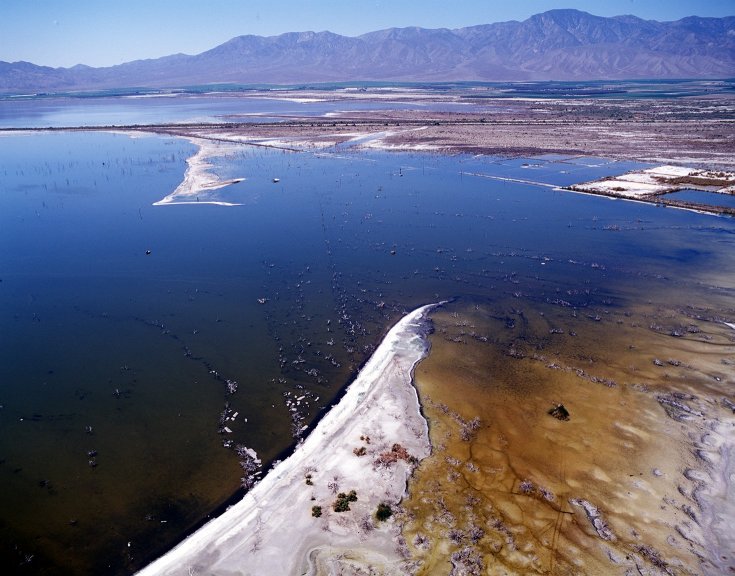Salton Sea
-
News Release – Nov. 29, 2022

Inflation Reduction Act Funds Landmark Agreements to Accelerate Salton Sea Restoration
WASHINGTON — The Department of the Interior announces a historic agreement funded by the Inflation Reduction Act that will mitigate impacts from the worsening drought crisis impacting the Salton Sea in Southern California. Read More
Overview
 Since the mid-1960's, studies have been conducted to determine methods of addressing the high salinity and water quality problems of southern California's Salton Sea and to help maintain its agricultural, environmental, and recreational values.
Since the mid-1960's, studies have been conducted to determine methods of addressing the high salinity and water quality problems of southern California's Salton Sea and to help maintain its agricultural, environmental, and recreational values.
In June 1993, the Imperial Irrigation District, Coachella Valley Water District, and Imperial and Riverside Counties formed the Salton Sea Authority. This group works with State and Federal government entities to develop plans to improve water quality, stabilize water elevation, and enhance recreational and economic development potential of the Sea.
In August 1994, the Authority, Reclamation, and the California Department of Water Resources (CDWR) signed an agreement that provided the basis for a cooperative effort to evaluate problems at the Sea. Under this agreement and subsequent amendments, several technical studies were completed including collecting localized weather data, modeling water currents, charting underwater topography, and evaluating potential methods of dike construction. In addition, a major effort was made to identify and compile potential solutions to the Sea's problems. A succeeding agreement was also signed between the Authority and Reclamation to jointly develop feasibility engineering and environmental compliance for a salinity and water surface evaluation management project.
Congressional representatives from the local area also formed a Congressional Task Force to provide political guidance and Federal funding for the efforts.
The Salton Sea Reclamation Act of 1998 (Public Law 105-372) directed the Secretary of the Interior, through Reclamation, to study options for managing the salinity and elevation of the Sea to preserve fish and wildlife health and to enhance opportunities for recreation use and economic development while continuing the Sea's use as a reservoir for irrigation drainage. Reporting requirements of the Act were met in January 2000, when the Department forwarded a draft EIS/EIR and several other reports to Congress. Since then, analyses have continued on options presented in those reports and on new options.
In January 2003, a status report was released by the Secretary of the Interior about the project, and in September of the same year, legislation was passed in which the State of California accepted responsibilities for ecosystem restoration at the Sea. The legislation directs CDWR to prepare an ecosystem restoration study and programmatic environmental document. The study, conducted in consultation with a legislatively mandated advisory committee and with the Authority, includes a proposed funding plan for implementing the preferred alternative.
Reclamation continues to work with CDWR and the Authority in a technical assistance role, and is funding a number of studies. Reclamation published the Salton Sea Salinity Control Research Project report which presents the findings of the project that was conducted at the Salton Sea Test Base between 2000 and 2003. An Environmental Assessment and Finding of No Significant Impact for a shallow water habitat pilot project that provides data for the successful design of saline shallow water ponds north of the Alamo River in Imperial County, California, has also been published. Reclamation also assisted the Authority in updating engineering designs based on collected geotechnical data, and is working with CDWR in implementing a biological study and providing hydrological modeling assistance. A report, Salton Sea Ecosystem Monitoring Project, published by the US Geological Survey in 2009, documents the results of a study to evaluate ecological risks and benefits of the shallow water saline habitat ponds prior to implementing widespread restoration actions.
In January 2007, a Draft Report (and news release) that provides a summary of Reclamation's study efforts to determine a preferred alternative action for managing the Salton Sea was published. In December 2007, Reclamation published a Final Report and Summary Report about the agency's study efforts to determine a preferred alternative action for managing the Salton Sea.
Reclamation continues to collect quarterly water samples at the Sea and influent rivers since 1999 to monitor salinity, selenium, nitrogen, phosphorus, and other water quality parameters. Water quality data from 2004 can be found here.
Maps depicting Salton Sea related information can be accessed through the links below. These maps will be periodically updated as new information becomes available.
- General Salton Sea and Vicinity Land Ownership and Management
- Salton Sea Projects
- Salton Sea Current and Projected Elevations
Additional informational and science documents associated with the Sea can be found in our Reports Archive under the Salton Sea topic area, or for more information about these efforts, contact Jeremy Brooks at jjbrooks@usbr.gov.

